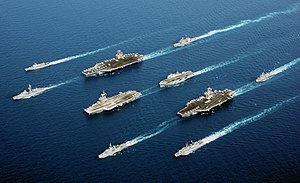
Back Vliegdekskip Afrikaans Portaavions AN Lyftcræftbora ANG حاملة طائرات Arabic Portaviones AST Aviadaşıyıcı Azerbaijani اوچاق داشییان ساواش گمیسی AZB Авианосец Bashkir Авіяносец Byelorussian Авіяносец BE-X-OLD


An aircraft carrier is a warship that serves as a seagoing airbase, equipped with a full-length flight deck and hangar facilities for supporting, arming, deploying and recovering shipborne aircraft.[1] Typically it is the capital ship of a fleet (known as a carrier battle group), as it allows a naval force to project seaborne air power far from homeland without depending on local airfields for staging aircraft operations. Since their inception in the early 20th century, aircraft carriers have evolved from wooden vessels used to deploy individual tethered reconnaissance balloons, to nuclear-powered supercarriers that carry dozens of fighters, strike aircraft, military helicopters, AEW&Cs and other types of aircraft such as UCAVs. While heavier fixed-wing aircraft such as airlifters, gunships and bombers have been launched from aircraft carriers, these aircraft have not landed on a carrier due to flight deck limitations.
The aircraft carrier, along with its onboard aircraft and defensive ancillary weapons, is the largest weapon system ever created. By their tactical prowess, mobility, autonomy and the variety of operational means, aircraft carriers are often the centerpiece of modern naval warfare, and have significant diplomatic influence in deterrence, command of the sea and air supremacy. Since the Second World War, the aircraft carrier has replaced the battleship in the role of flagship of a fleet, and largely transformed naval battles from gunfire to beyond-visual-range air strikes. In addition to tactical aptitudes, it has great strategic advantages in that, by sailing in international waters, it does not need to interfere with any territorial sovereignty and thus does not risk diplomatic complications or conflict escalation due to trespassing, and obviates the need for land use authorizations from third-party countries, reduces the times and transit logistics of aircraft and therefore significantly increases the time of availability on the combat zone.

There is no single definition of an "aircraft carrier",[citation needed] and modern navies use several variants of the type. These variants are sometimes categorized as sub-types of aircraft carriers,[2] and sometimes as distinct types of aviation-capable ships.[3] Aircraft carriers may be classified according to the type of aircraft they carry and their operational assignments. Admiral Sir Mark Stanhope, RN, former First Sea Lord (head) of the Royal Navy, has said, "To put it simply, countries that aspire to strategic international influence have aircraft carriers."[4] Henry Kissinger, while United States Secretary of State, also said: "An aircraft carrier is 100,000 tons of diplomacy."[5]
As of January 2025, there are 50 active aircraft carriers in the world operated by fifteen navies. The United States has 11 large nuclear-powered CATOBAR fleet carriers — each carrying around 80 fighters — the largest in the world, with the total combined deck space over twice that of all other nations combined.[6] In addition, the US Navy has nine amphibious assault ships used primarily as helicopter carriers, although these also each carry up to 20 vertical/short takeoff and landing (V/STOL) jetfighters and are similar in size to medium-sized fleet carriers. China, the United Kingdom and India each currently operate two STOBAR/STOVL aircraft carriers with ski-jump flight decks, with China in the process to commission a third carrier with catapult capabilities, and France and Russia each operate a single aircraft carrier with a capacity of 30 to 60 fighters. Italy operates two light V/STOL carriers, while Spain and Turkey operate one V/STOL aircraft-carrying assault ship. Helicopter carriers are also operated by Japan (4, two of which are being converted to operate V/STOL fighters), France (3), Australia (2, previously also owned 3 light carriers), Egypt (2), South Korea (2), China (3), Thailand (1) and Brazil (1). Future aircraft carriers are under construction or in planning by China, France, India, Italy, Russia, South Korea, Turkey and the United States.
- ^ "Aircraft carrier", Dictionary, Reference, archived from the original on 19 February 2014, retrieved 3 October 2013
- ^ "Encyclopaedia", Encyclopædia Britannica, archived from the original on 5 October 2013, retrieved 3 October 2013,
Subsequent design modifications produced such variations as the light carrier, equipped with large amounts of electronic gear for the detection of submarines, and the helicopter carrier, intended for conducting amphibious assault. ... Carriers with combined capabilities are classified as multipurpose carriers.
- ^ Petty, Dan. "Fact File: Amphibious Assault Ships – LHA/LHD/LHA(R)". United States Navy. Archived from the original on 3 September 2009. Retrieved 15 November 2015.
- ^ "Aircraft carriers crucial, Royal Navy chief warns". BBC News. 4 July 2012. Archived from the original on 25 September 2015. Retrieved 15 November 2015.
- ^ "The slow death of the carrier air wing". jalopnik.com. 19 July 2017. Archived from the original on 11 January 2018. Retrieved 10 January 2018.
- ^ Drew, James (8 July 2015). "US 'carrier gap' could see naval air power dip in Gulf region". FlightGlobal. Archived from the original on 17 November 2015. Retrieved 15 November 2015.